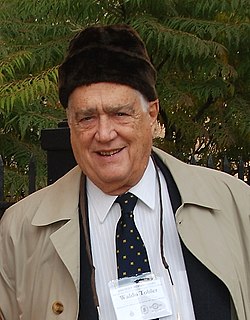Tobler's second law of geography

The second law of geography, according to
geographers, there are a few contenders for the title of the second law of geography.[5] Tobler's second law of geography is less well known but still has profound implications for geography and spatial analysis.[6]
Tobler's second law of geography has implications whenever a boundary is drawn on a map, particularly in arbitrary boundaries such as political borders.
Foundation
In
boundary problem, and the Uncertain geographic context problem (UGCoP).[8][9][10] In the boundary problem in particular, when geographic boundaries are arbitrary and not based on natural features, the phenomena under evaluation is likely to continue and be influenced by space beyond the study area.[11][12]
Controversy
In general, some dispute the entire concept of laws in geography and the social sciences.[2][5] These criticisms have been addressed by Tobler and others.[2][5] However, this is an ongoing source of debate in geography and unlikely to be resolved anytime soon.
Other proposed second laws of geography
Some have argued that geographic laws do not need to be numbered. However, the existence of a first invites the creation of a second. In addition to Tobler's second law, several scholars have proposed candidates for a second.
- Arbia's law of geography: "Everything is related to everything else, but things observed at a coarse spatial resolution are more related than things observed at a finer resolution."[2][13][14]
- Spatial heterogeneity: This concept has a longer history than the first law of geography and dates back to regional geography that emphasizes heterogeneity as "an inescapable characteristic of geography".[15] Spatial heterogeneity was first proposed as "a possible candidate" of the second law of geography by Michael F. Goodchild, who attributes this law to David Harvey.[5] Chinese geographers often cite it simply as the "second law of geography".[16]
- Tim Foresman and Ruth Luscombe's Second law of geography: "Things that know where they are can act on their locational knowledge. Spatially enabled things have increased financial and functional utility."[17]
- the uncertainty principle: "that the geographic world is infinitely complex and that any representation must therefore contain elements of uncertainty, that many definitions used in acquiring geographic data contain elements of vagueness, and that it is impossible to measure location on the Earth's surface exactly."[5]
- It has been proposed that Tobler's first law of geography should be moved to the second and replaced with another.[5]
See also
References
- ^ .
- ^ S2CID 33201684. Retrieved 10 March 2022.
- ISBN 9781804616468. Retrieved 24 January 2024.
- ^ Thompson, Alexandra (11 January 2024). "Geeking Out on Geography: Mapping the Effects of the Coastal Barrier Resources Act". Resource Magazine. Retrieved 24 January 2024.
- ^ S2CID 17912938.
- S2CID 233602210.
- ^ Tobler W., (1970) "A computer movie simulating urban growth in the Detroit region". Economic Geography, 46(Supplement): 234–240.
- S2CID 52024592.
- ISBN 0-86094-134-5.
- S2CID 255206315.
- ISBN 978-94-009-8117-1.
- ISBN 9780511623356.
- ^ Arbia, Giuseppe; Benedetti, R.; Espa, G. (1996). ""Effects of MAUP on image classification"". Journal of Geographical Systems. 3: 123–141.
- ^ Smith, Peter (2005). "The laws of geography". Teaching Geography. 30 (3): 150.
- JSTOR 2561063.
- S2CID 61153749.
- S2CID 8531285.
